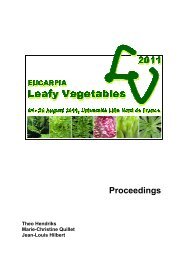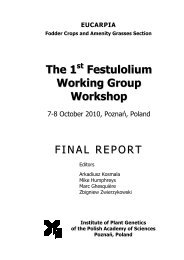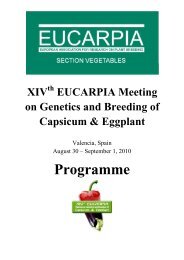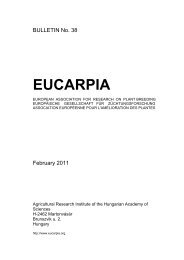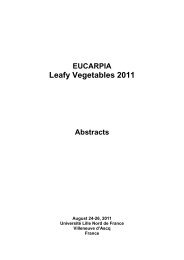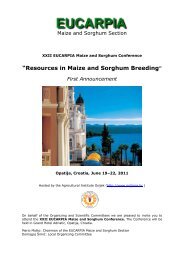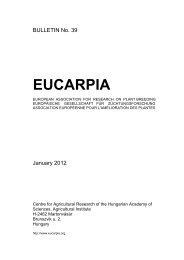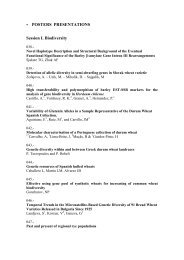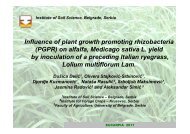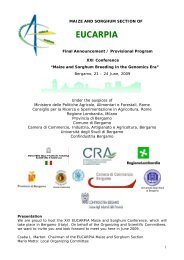Plant breeding for organic and sustainable, low-input agriculture
Plant breeding for organic and sustainable, low-input agriculture
Plant breeding for organic and sustainable, low-input agriculture
You also want an ePaper? Increase the reach of your titles
YUMPU automatically turns print PDFs into web optimized ePapers that Google loves.
SUSVAR - Winter wheat ringtest over 15 environments in Europe – Results<br />
Franziska Löschenberger 1 , Gheorghe Ittu 2 , Hubert Kempf 3 , Bernard Roll<strong>and</strong> 4<br />
David Schneider 5<br />
1 Saatzucht Donau, Probstdorf, Austria; 2 RICIC Fundulea, Romania; 3 Saatzucht Schweiger, Moosburg,<br />
Germany; 4 INRA Rennes, France; 5 Agroscope Changins-Wädenswil ACW, Switzerl<strong>and</strong>.<br />
The SUSVAR (www.cost860.dk) bread wheat ringtest aims at comparing the per<strong>for</strong>mance of a<br />
particular set of varieties over contrasting environments across Europe with an emphasis on <strong>low</strong><strong>input</strong><br />
<strong>and</strong> <strong>organic</strong> conditions. GxE interaction, specific <strong>and</strong> broad adaptation to environments,<br />
stability of yield <strong>and</strong> quality as well as research <strong>for</strong> particularly useful germplasm, traits <strong>and</strong><br />
ideotypes <strong>for</strong> <strong>low</strong>-<strong>input</strong> <strong>and</strong> <strong>organic</strong> farming – <strong>for</strong> both direct use <strong>and</strong> <strong>breeding</strong> – are the main<br />
interest of the testing network to the participants.<br />
The ring test was per<strong>for</strong>med on 15 different pedoclimatic environments from France (F) to<br />
Romania (RO), all without fungicides, ranging from <strong>organic</strong> (Org) to conventional without<br />
fertilisation (N0) or “<strong>low</strong> <strong>input</strong>” (LI) to a few “high <strong>input</strong>“(HI).<br />
In the <strong>organic</strong> trials of Romania, Germany <strong>and</strong> Austria the best yielding genotype was always<br />
coming from the respective country, reflecting the station or region of selection (Table: grey).<br />
This shows the importance of specific adaptation to regional agro-environmental conditions <strong>and</strong><br />
the success of local <strong>breeding</strong> ef<strong>for</strong>ts in the past, but it also stresses the need <strong>for</strong> better<br />
characterization of the environments. The yield results from six conventional N0 or LI trials are<br />
highly correlated with Org trials (r=0,77*). The HI trial results are not related to neither Org nor<br />
N0+LI. Protein content of the genotypes is similarly correlated between all three “<strong>input</strong> groups”:<br />
ORG to N0+LI: r=0,74**; NO+LI to HI: r=0,64*, ORG to HI: r=0,70**.<br />
Calculation of the dynamic stability parameter “ecovalence” according to Becker & Leon (1998)<br />
revealed Titlis, Aurolus, Cornelius, Zinal <strong>and</strong> Bitop as first ranking <strong>for</strong> yield stability.<br />
Winter hardiness, tillering capacity, early ground cover, plant height at booting, hanging growth<br />
habit, vigorous growth dynamics <strong>and</strong> high leaf area index as well as final plant height all<br />
significantly <strong>and</strong> positively influenced protein yield evaluated in <strong>organic</strong> trials. Disease<br />
resistance did not show any significant correlation to mean yield or other agronomic traits.<br />
Both LI <strong>and</strong> Org trials are useful <strong>for</strong> <strong>low</strong>-<strong>input</strong> <strong>and</strong> <strong>organic</strong> selection. Local adaptation was<br />
advantageous under some of the <strong>organic</strong> conditions. Under <strong>organic</strong> conditions protein yield was<br />
significantly influenced by several well defined criteria, which may facilitate selection <strong>for</strong><br />
improved varieties.<br />
Country/location RO D F-2 R CH F-3 F-2 RO A F-1 A F-1 F-3 CH CH<br />
System Org Org Org NO NO Org LI HI Org Org HI LI LI LI HI<br />
Fertilizer kg N/ha 0 0 50 0 0 0 90 100 0 0 130 40 100 100 180<br />
Mean yield t/ha 1,64 3,59 3,74 4,32 5,02 5,15 5,21 5,22 5,26 5,71 6,36 6,63 7,56 7,69 8,26<br />
Best three varieties JP NA DI AR DI ZI FO AR CO CF JN DI DI DI CO<br />
Grey: origin = testing BI ZI RE RE NA NA DI RE AU RE CO CF CO CO DI<br />
country CO CO FO JN CO CF CF JP NA DI AR RE CF CF JP<br />
Mean Protein %DM 10,0 -- 10,6 11,8 9,7 -- 12,3 13,8 15,3 13,3 16,4 12,0 11,7 11,7 13,7<br />
Best three varieties SI AU TI BI RE AU SI AU AU TI TI AU TI<br />
Grey: origin = testing DI BI AU AU JP BI TI TI TI AU AU TI SI<br />
country AR TI BI JN AR CF AU SI SI BI BI SI AU<br />
Varieties/ country: RO: Ardeal 1=AR; Junona=JN; Jupiter=JP; F: CF99102=CF; DI9714=DI; Renan=RE; D: Format=FO; Naturastar=NA;CH:<br />
Siala=SI; Zinal=ZI, Titlis=TI; A: Bitop=BI; Aurolus=AU; Cornelius=CO.<br />
18




